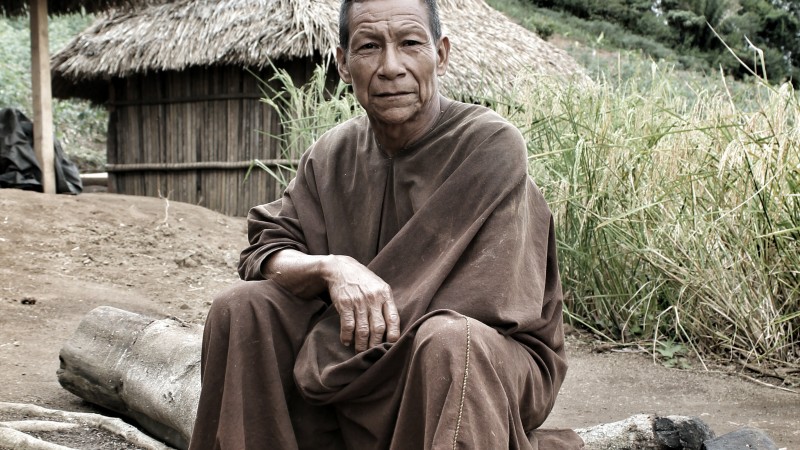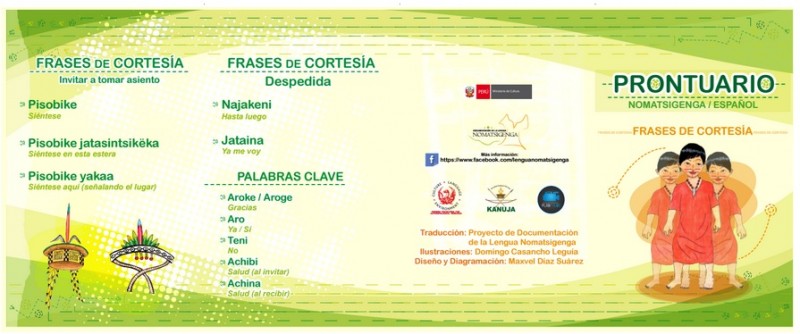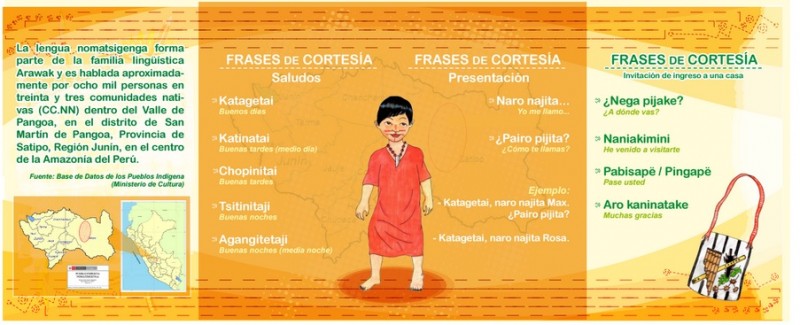
Member of the Nomatsigenga community. Image provided by the project.
The Nomatsigenga, pronounced [nomatsi'geŋa], are people that live in 33 native communities in the Pangoa Valley, at the center of the Peruvian Amazonia, whose language is endangered.
According to Alexandra Aikhenvald, a linguist specializing in Amazon languages, their language belongs to the Kampa ethnolinguistic branch, which in turn belongs to the Arawak family.
The Nomatsigenga's diverse base of traditional knowledge is also disappearing with time. To prevent that, an Archive of the Nomatsigenga Language and Culture has been created, as explained on the website Nomatsigenga:
[…] el primer repositorio digital creado de manera conjunta y participativa con el objetivo de registrar, visibilizar y hacer perdurable la lengua y cultura de nuestro pueblo. Esta iniciativa es el resultado de una colaboración entre el pueblo nomatsigenga, el Proyecto de Documentación de la Lengua Nomatsigenga (DLN); Organización KANUJA, Firebird Foundation y el Ministerio de Cultura.
[…] the first digital archive was created jointly with the aim of recording and making the language and culture of our people visible and enduring. This initiative is the result of a collaboration between the Nomatsigenga people, the Nomatsigenga Language Documentation project (DLN); the KANUJA Organization, the Firebird Foundation and the Ministry of Culture.
Global Voices talked to Gerardo Manuel García, the project director, about the initiative.
Global Voices (GV): How did the idea of creating the digital archive appear and what steps have been taken to make this project a reality?
Gerardo Manuel Garcia (GMG): Cuando los científicos realizan trabajo de investigación de campo y recopilan, registran la información en una lengua indígena. En el mejor de los casos, conservan la información en un acervo dirigido por instituciones ubicadas en el extranjero, como por ejemplo el Archive of the Indigenous Languages of Latin America de la Universidad de Texas o el Archivo Dobes. La desventaja de este sistema es que la propia comunidad hablante de esa lengua no tiene acceso a los audios, videos y fotografías del investigador. Nuestra idea fue proponer un repositorio digital y de acceso libre, para que así los propios hablantes lo asuman como suyo y puedan actualizarlo con información de su pueblo y lengua. A inicios de 2015 surgió el Acervo Digital de la Cultura y Lengua Nomatsigenga.
Gerardo Manuel Garcia (GMG): When the scholars carry out field research and compile, they record information using indigenous language. At best, they preserve the information in an archive run by institutions based abroad, such as the Archive of the Indigenous Languages of Latin America at the University of Texas or the Dobes Archive. The disadvantage of this system is that the community who speaks that language itself doesn't have access to the audios, videos and images of the researcher. Our idea was to propose a free digital archive, so the speakers themselves might take it as theirs and be able to update it with information about their community and language. In early 2015 the Digital Archive of Nomatsigenga Culture and Language was created.
GV: What can you tell us about the Nomatsigenga language?
GMG: Para la UNESCO, el nomatsigenga está en peligro de extinción; apenas la usan unas 8,000 personas en la selva central del Perú, distrito de San Martín de Pangoa, provincia de Satipo, región Junín. Fue por eso que decidimos documentar la tradición oral de esta lengua recopilando mitos, leyendas, canciones, cuentos, discursos, autobiografías, para crear un acervo digital donde salvaguardar la información, comenzando por su tradición oral hasta medicina tradicional. El Acervo el Acervo Digital de la Cultura y Lengua Nomatsigenga es producto del trabajo realizado entre el Proyecto de Documentación de la Lengua Nomatsigenga, las comunidades nativas, la organización indígena KANUJA, el Ministerio de Cultura, la Municipalidad Distrital de San Martín de Pangoa y el apoyo financiero de la Firebird Foundation.
GMG: According to UNESCO, the Nomatsigenga language is endangered; it has only 8000 speakers in the central Amazon region of Peru, San Martín de Pangoa district, Satipo province, Junín region. That's why we decided to register this language and its oral tradition by compiling myths, legends, songs, tales, speeches, autobiographies to create a digital archive to preserve the information, starting from oral tradition and running all the way through traditional medicine. The Digital Archive of the Nomatsigenga Culture and Language is the result of the work carried out jointly by the Nomatsigenga Language Documentation Project, the native communities, the indigenous organization KANUJA, the Ministry of Culture, the San Martín de Pangoa district municipality and the financial support offered by Firebird Foundation.
GV: What role for Nomatsigenga youth in the project?
GMG: Los hablantes de las lenguas amazónicas son mayoritariamente jóvenes y la lengua nomatsigenga no es la excepción. En el Proyecto de Documentación de la Lengua Nomatsigenga están involucrados directamente jóvenes, María Manay Chimanga y Magadalena Chimanga Chanqueti. A partir de su participación en la recopilaciòn de información tradicional de su pueblo se han encontrado a sí mismas, pues como dicen “los sabios se están muriendo y todas la información y la lengua está muriendo con ellos. Es por eso que necesitamos recopilar y recuperar”. De la misma manera, las hermanas Guisenia y Herlinda Rodríguez de la comunidad de Mazaronquiari aportan al proyecto con discusiones y propuestas. Es muy importante la participación activa de los jóvenes, pues ellos serán el incentivo para más jóvenes documenten su lengua y cultura.
GMG: The speakers of the Amazon languages are mostly young people and Nomatsigenga language is no exception. At the Nomatsigenga Language Documentation Project the youth, such as María Manay Chimanga and Magadalena Chimanga Chanqueti, are directly involved. From their participation in compiling the traditional information of their community, they have found themselves “compiling and recovering”, since “wise men are dying and all information and language are dying with them.” Likewise, sisters Guisenia y Herlinda Rodríguez from the community of Mazaronquiari participate in the project with discussions and proposals. The active participation of the youth is very important. That will encourage more youth to document their language and culture.
GV: What is their main economic activity?
GMG: Los nomatsigenga son mayoritariamente agricultores y comercializan sobretodo el cacao y el maíz.
GMG: Nomatsigengas are mainly farmers and trade mostly cacao and corn.
GV: About the documentary — what stage of production is it at and how can we watch it?
GMG: El Documental Nomatsigenga, que se encuentra en proceso, ha sido ampliado. Mientras más se visitan las distintas comunidades nomatsigenga de Pangoa, cerca de 36 comunidades, se encuentran diferencias lingüísticas y culturales entre los pueblos. Es por eso que nuestro documental aún está en proceso. A pesar de que el documental se encuentra en elaboración se han producido materiales audiovisuales como nuestro reciente video sobre el V Encuentro de los Pueblos Nomatsigenga y Ashaninka.
GMG: The Nomatsigenga Documentary is in progress and [the production period] has been extended. The more you visit the various Nomatsigenga communities in Pangoa — about 36 communities in total — the more linguistic and cultural differences you find between the communities. That's why our documentary is still a project in progress. Although it's still at the production stage, there is some audiovisual footage [already available], as our recent video about the V Conference of Nomatsigenga and Ashaninka Communities shows.
GV: Thank you very much, Gerardo.
Below are some phrases in the Nomatsigenga language:










1 comment